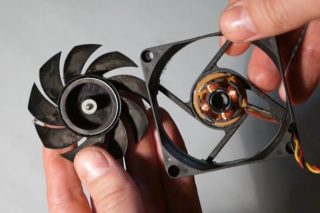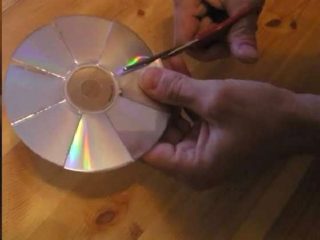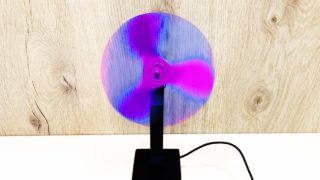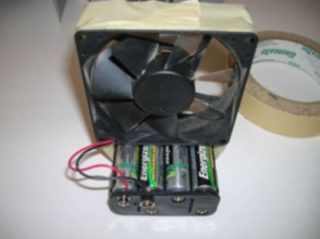With the onset of summer, heat becomes a real problem, which complicates the conduct of any events, deprives people of comfort and coziness. An inexpensive and practical way out of an unpleasant situation can be a home-made fan made of auxiliary materials and accessories. The manufacture of this device will save on the purchase of factory goods and it will be interesting to spend time assembling. To make a choice in favor of one solution or another, it was easier, you need to figure out what you can make a fan with your own hands.
Fan design aspects

Before proceeding with the design, it is necessary to imagine the device of a cooling type product. By location, they can be floor-standing, ceiling-mounted and table-top.
Both factory and home-made fans consist of the following parts:
- Propeller. The larger its diameter, the more air will be supplied to the object.
- Electric motor. A product powered by a household outlet, adapter, batteries or rechargeable batteries can be used. The performance of the finished fixture is directly proportional to the power of the motor.
- Stand. Here you need to show imagination and ingenuity. The stand must meet criteria such as safety, stability and presentability.
- The wire. For a small motor, any cable left over from a broken watch, lamps and other small household appliances is suitable. It is advisable to install a switch on the wire in order to operate the device without getting up. If you plan to connect to USB, an extension cable, a cable from an old mouse or keyboard will do.
The starting point for starting design and construction is the search for a motor. If you have unwanted tools, toys, and kitchen utensils in your home, donate them. Engines from a drill, a screwdriver, a screwdriver, a mixer, a children's car, a trimmer, an electric shaver can be used. Sometimes in the apartment you can find broken coolers from system units or laptop stands. Given the saturation of modern housing with technology, finding a motor is not difficult.
Required materials and equipment

Since all air coolers have almost the same design, the kit for their manufacture will be standard.
To make a compact and quiet fan at home you will need:
- ruler, square, pencil;
- soldering iron;
- scotch tape, scissors, stationery knife;
- motor for 220 or 12 V;
- cable with appropriate plug;
- thermal glue;
- Styrofoam;
- CD discs;
- wine cork made from natural material;
- cardboard sleeve and box;
- insulating tape;
- construction hair dryer, candle or lighter.
To work safely, you should do it with goggles and construction gloves. Good ventilation must be provided when handling the soldering iron.
DIY fan options

Having an electric motor at your disposal, you should come up with a reliable, stable and beautiful base for it. It is better to use foam as a socket for the motor housing. A niche is cut out for the device, after which it is glued with silicone.
Then the following actions are carried out:
- 7 thick cocktail tubes are glued together.
- Wires are passed through them in the right quantity and with a sufficient margin.
- In a wide and low plastic bottle, holes are made for wiring and a channel switch. The joints are sealed with sealant.
- Sand, cement or lead shot is poured into the container to give the stand weight.
- The glued tubes are inserted into the neck of the bottle to the desired depth and fixed with glue or colored tape.
- The connection of the foam bed and the stand is carried out. The final connection of the wires and power supply is made.
In conclusion, the decoration of the product is carried out. For this, paint, duct tape, decoupage or paper are used. A CD can be glued to the bottom of the bottle, which will give the structure a presentable look and additional stability.
The simplest solution to the blades issue is a CD. Manufacturing is carried out in the following sequence
- The disk is split into 4, 6, or 8 identical sectors.
- With a soldering iron, a heated knife or a grinder, slots are made to the opaque base of the disc.
- The products warm up at the base, the petals turn in one direction. You need to watch that the angle of attack is the same everywhere.
- The blades are cleaned with a knife or file.
- A bottle cap is inserted into the center hole. A hole is made in it for the motor rotor.
- The motor and propeller are connected together. Once perfect centering is achieved, the docking station is locked.

It remains to fix the finished block on the stand and decorate it.
Using a cork as the central axle attachment, a propeller is made from a plastic bottle. The work is performed in the following sequence:
- A plastic bottle with a capacity of 1.5 liters of the desired color is selected.
- The neck is cut at the level of the top of the label.
- The upper part is divided into 4, 6 or 8 sectors. Cutting is carried out along the marking lines until the compaction area is reached.
- The blades are given a rounded configuration. Better to do this with a template.
- The bases of the petals are heated over the fire and rotated to a certain angle. Each time you need to stand for a few minutes for the plastic to cool and take a new shape.
- A wine stopper is tightly inserted into the cap screwed onto the neck. A neat hole is made in the center to fit the motor axis.
- Glue is added to the hole, after which the propeller is pushed onto the motor shaft. While the glue has not solidified, the fan is centered.
The final stage is the installation of the block on the base and its design.
An even simpler measure is to make a propeller out of cardboard or thick paper. Manufacturing is carried out in the following sequence:
- A sleeve is glued from several layers of thick cardboard. In order for the product to have sufficient strength, it should be treated with a primer so that the cardboard is soaked through and through.
- An empty rod from the handle, a cocktail tube or a telescopic antenna link from the receiver is glued into the center of the sleeve. The motor shaft will be inserted into this hole.
- Align the sleeve to be as round as possible.
- Cutting the propeller blades to a template. This is the condition that they all turn out to be the same, and the cooler will be quiet, and will not create vibration during operation. The petal bases are matched to the bushing to achieve a complete fit.
- The places of fixation of the blades are marked. They are attached to thermal glue. The more petals, the better the balance of the propeller will be.
Finally, the finished product is painted with waterproof paint. After that, it will not swell from dampness, and it will be faster and easier to remove dirt from it.
A bladeless fan is made from a computer cooler by placing it in a pipe. The advantage of this solution is that the air flow will be concentrated and directed.

A fan from a cooler is made by hand in the following sequence:
- The cooler is being measured. The diagonal of the square will be the minimum pipe diameter that you need to find or make yourself.
- The housing for the propeller is selected or made independently. This can be a plastic sewer pipe or a rolled-up piece of flexible cardboard, plastic, or metal. The edges of the cylinder are glued, stapled or riveted.
- A circle is cut out corresponding to the shape of the inner section of the body. A cooler is attached to it, excess material is cut out under the propeller opening.
- The wires are connected, the block with the cooler is inserted into the cylinder, aligned and glued.
It remains to make an adjustable stand and decorate the product.
To make a homemade 12 volt fan, you can use a power supply for a laptop, LED lamps, or other household appliances of the appropriate voltage. The connection is made through the connector, and the device itself is turned on using the red button on the left.
The modernization of the operating fan is carried out when the devices, for one reason or another, cease to satisfy their owners. To this end, a new propeller with enlarged petals is being made, LED strips and boards are installed on the body, and a continuous power control switch is inserted.








